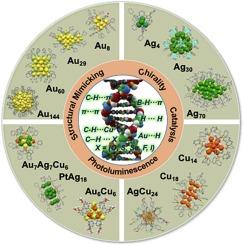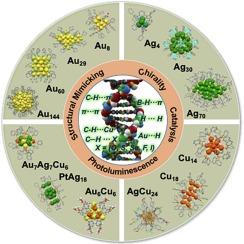Helical self-assemblies of molecule-like coinage metal nanoclusters and their emerging applications
IF 20.3
1区 化学
Q1 CHEMISTRY, INORGANIC & NUCLEAR
引用次数: 0
Abstract
Ligand protected atomically precise coinage metal (Au, Ag, Cu) nanoclusters (NCs) have attracted considerable interest for their distinctive structural self-assemblies. A recent trend involves exploring the creation of synthetic NCs capable of self-assembling into diverse superstructures with compact helical conformations. These interesting structures are analogous to folded states found in natural proteins. The formation of such supramolecular self-assemblies of NCs is primarily dictated by subtle intra and inter-cluster non-covalent interactions. These include C-H‧‧‧π, π‧‧‧π, H‧‧‧H, and auro/argento/cupro-philic interactions mediated through surface ligands and metal cores. This review offers a comprehensive insight into the self-assembly mechanisms governing cluster-based helical superstructures. It presents a meticulously designed approach tailored for the construction of atomically precise helical supramolecular materials, specifically focusing on coinage metal NCs. Additionally, it explores the amplification of physicochemical properties triggered by self-assembly and delves into their potential applications in chiral recognition, enantioselective catalysis, molecular sensing and photoluminescence studies. The subject addressed in this review is closely linked to cutting-edge advancements in the precise coinage metal NCs field.


类分子共价金属纳米团簇的螺旋自组装及其新兴应用
受配体保护的原子精确硬币金属(金、银、铜)纳米团簇(NCs)因其独特的结构自组装而备受关注。最近的一个趋势是探索创造能够自组装成具有紧凑螺旋构象的各种超结构的合成 NC。这些有趣的结构类似于天然蛋白质中的折叠状态。这种数控超分子自组装的形成主要受簇内和簇间微妙的非共价相互作用的支配。这些相互作用包括 C-H‧‧π、π‧‧π、H‧‧‧H,以及通过表面配体和金属核介导的乌洛/精子/超亲水相互作用。这篇综述全面介绍了基于团簇的螺旋超结构的自组装机制。它提出了一种精心设计的方法,专门用于构建原子精度的螺旋超分子材料,尤其侧重于共价金属 NC。此外,它还探讨了自组装引发的物理化学特性的放大,并深入研究了它们在手性识别、对映选择性催化、分子传感和光致发光研究中的潜在应用。本综述所探讨的主题与精密铸币金属 NC 领域的前沿进展密切相关。
本文章由计算机程序翻译,如有差异,请以英文原文为准。
求助全文
约1分钟内获得全文
求助全文
来源期刊

Coordination Chemistry Reviews
化学-无机化学与核化学
CiteScore
34.30
自引率
5.30%
发文量
457
审稿时长
54 days
期刊介绍:
Coordination Chemistry Reviews offers rapid publication of review articles on current and significant topics in coordination chemistry, encompassing organometallic, supramolecular, theoretical, and bioinorganic chemistry. It also covers catalysis, materials chemistry, and metal-organic frameworks from a coordination chemistry perspective. Reviews summarize recent developments or discuss specific techniques, welcoming contributions from both established and emerging researchers.
The journal releases special issues on timely subjects, including those featuring contributions from specific regions or conferences. Occasional full-length book articles are also featured. Additionally, special volumes cover annual reviews of main group chemistry, transition metal group chemistry, and organometallic chemistry. These comprehensive reviews are vital resources for those engaged in coordination chemistry, further establishing Coordination Chemistry Reviews as a hub for insightful surveys in inorganic and physical inorganic chemistry.
 求助内容:
求助内容: 应助结果提醒方式:
应助结果提醒方式:


